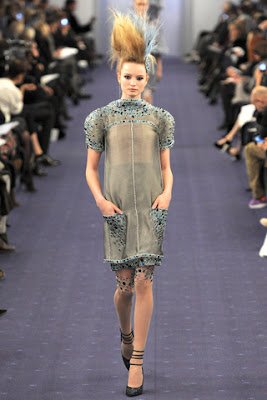This week Paris is host to some of the most exclusive and eagerly awaited fashion shows of the season. During the Couture week, a selected group of fashion empires show their Couture collection to the cream of the crop: celebrities, royalty and of course the international press.
For a couple of days, the fashion world becomes even more exclusive than it already is. Yesterday the three days of haute couture madness were kicked off by the house of Versace. There will be a total of 23 shows, including Elie Saab, Valentino and Givenchy. Peanuts compared to the more than 80 ready-to-wear shows that were held in Paris a couple of months ago.
You could say that the structure of the fashion industry is in essence a pyramid, with haute couture making out the highest order.
The difference with ready-to-wear is that haute couture consists of exclusive garments tailored for a specific customer. Often the pieces are made in luxurious and expensive materials, but more importantly, they are entirely handmade. Minute detailing and the use of time-consuming techniques are also often employed in Haute Couture ateliers. 'Haute Couture' is a legally protected term in France, which can only be used by selected brands that meet certain quality standards. The official "Chambre Syndicale de la Haute Couture" currently has thirty members.
The difference with ready-to-wear is that haute couture consists of exclusive garments tailored for a specific customer. Often the pieces are made in luxurious and expensive materials, but more importantly, they are entirely handmade. Minute detailing and the use of time-consuming techniques are also often employed in Haute Couture ateliers. 'Haute Couture' is a legally protected term in France, which can only be used by selected brands that meet certain quality standards. The official "Chambre Syndicale de la Haute Couture" currently has thirty members.
Yesterday,
before his show, Giambattista Valli told the press he wants to have the Haute
Couture ateliers be made Unesco World Heritage. It hasn't come to that yet, but
in a society where a growing percentage of people are anxious to preserve
tradition, whether it be material or intangible, who knows?
This season Haute Couture takes on a modern form. In the collection of Bouchra Jarrar for example. She effortlessly combines materials and different worlds in wearable pieces. It's the ultimate luxury for the woman of today: unique clothing that is practical and made for an urban setting.
 |
| Bouchra Jarrar, Spring 2012 Couture
Alexis Mabille uses colour and plastic-like materials to create an otherworldly show.
|
 |
| Alexis Mabille, Spring 2012 Couture |
The two collections above stray far from the traditional Couture esthetic. The latter can be found in the collection of Versace, since long an important voice in the world of Haute Couture.
 |
 |
| Versace, Spring 2012 Couture |
Although I'm not a fan of the styling, the dresses do bring a surprising mix of Hollywood glamour and warrior influences.
A marriage between tradition and modernity, that's the way some designers are looking at the Haute Couture phenomenon these days.
The layered constructions of Bill Gaytten for Dior have a fifties feel, but the sheerness and unfinished semblance of the clothing is very now.
 |
| Dior, Spring 2012 Couture |
Giambattista Valli on the other hand makes use of the craftsmanship so specific to Haute Couture in a way that looks timeless: neither historical, nor futuristic.
 |
| Giambattista Valli, Spring 2012 Couture |
Chanel lays down a very youthful and rebellious look with the help of a punk inspired styling. But the clothes themselves are modern of cut and lend the somewhat antiquated tweed suit an almost, selfmade, disposable air.
 |
| Chanel, Spring 2012 Couture |
Haute Couture doesn't have to be a distant elitist fragment of the fashion world.
It shows the endless possibilities of fabrics and ensures the passing on of the metier.
Most importantly ... it encourages to dream.
The Mere Alchemist















































